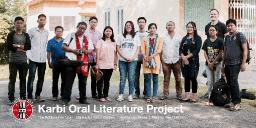
Recently Rated:
Stats
Work interests: Social Anthropology, Ethnomusicology, Religious Studies, Philosophy, Indigenous Studies
Affiliation/website: http://www.kohimainstitute.org
Preferred contact method: Any
Preferred contact language(s): English
Contact:
Favourite publications:
Preserving the Karbi Kecharhe Alun Funeral Epic in Assam

I'm very excited to share about my latest research work in Assam. Presently, I'm running a project titled: "Preserving the Karbi Kecharhel Alun Funeral Epic in Assam". The aim of this project is to record, transcribe, translate, annotate and musically notate five full versions of the Kecharhe Alun funeral epic from five different regions of Karbi Anglong, eastern Assam. Performed from memory, the Kecharhe Alun is the most significant, and longest (several days) single piece of chanted poetry in the Karbi oral literature repertoire, though it has never been thoroughly studied, or properly recorded, transcribed, or archived. As the indigenous Karbi population of Assam, numbering 419,534 (2001 India Census), is scattered throughout Eastern and Western Karbi Anglong districts in Assam, regional variations in the epic exist. Moreover, both the gender and social status of the deceased person are also important factors, and entail additional variations in the narrative. Thus, the project aims to identify and publish in book form (with accompanying digital audio copy) an ‘authoritative’ version, based on level of detail, quality, and complexity, and to document the above-mentioned variations as annotations to the fully articulated and musically notated single version.
The Karbi language and ethnic group
The Karbi (Karbi: কাৰ্বি) people, often referred to by early anthropologists (and in the Constitution Order of the Government of India) as ‘Mikir’, are one of the largest ethnic groups in Northeast India, and mostly based in Karbi Anglong, which is comprised of Eastern and Western Karbi Anglong districts. The Karbi language is generally classified as Tibeto-Burman, though a systematic study has yet to be done on the Karbi grammar. Genetic affiliation with the Tibeto-Burman family has also not provided conclusive evidence of clear linkages with other Tibeto-Burman languages in the region such as, for example, the Naga linguistic groups immediately to the East of Karbi Anglong. In fact, systematic studies of the more than 200 distinct languages of Northeast India are scarce, and the Karbi language and dialects - Chingthang (Jynthong), Mirlong, Rong Kethang (Rengkhang, Rongkhang) - are no different. The central organisation working on Karbi language and literature is the Karbi Lammet Amei (Karbi Literary Association), and this project will work closely with KLA in the final transcription and archival process of the Kecharhe Alun recordings.
Description of the funeral epic
The Kecharhe Alun is sung by a Charhepi or female dirge singer, who carefully guides the soul of the deceased through vast, often treacherous landscapes, on a journey to the village of ancestors (aka ‘village of the dead’). The Kecharhe Alun epic also describes in detail the names of ancient terrains, landmarks, along with their inhabitants - fauna and spirits - known in Karbi folklore as important descriptors and markers of long-lost ancestral migration routes. The activities that surround the Kecharhe Alun certainly compose the rich tradition of Karbi death rituals, but they may also be seen as a cultural culmination, namely the juncture in which life-cycle rituals achieve their fullest realisation. Thus, the Kecharhe Alun constitutes the most important cultural repository, elucidating Karbi mythology, notions of personhood and human and other-than-human relations, ecology, and cosmology more generally.
Sections of the Keharche Alun epic
The Kecharhe Alun includes the ‘entire sequence of rituals performed after an occurrence of death till the cremation in the following order’ (Teron 2014):
-
Dim-klong Kesei – Preparation of a bed for the deceased.
-
Lang Kepanglu—The deceased is dressed in mourning attire after ritual bathing.
-
An Kepi —Rice (sang), egg (voti), big dried fish (toman), salt (ingtí) and mustard seeds (jangmu) are cooked together and the preparation is called ‘anjam’, which is food for the dead. The cooking takes place in the kitchen (kut, or sirkut) of the household, which is located in the innermost part of the dwelling under the supervision of the female priestess, uchepi.
-
Ingtat Kepi – Relatives of the deceased offer betel nuts and leaves on the body of the deceased as last respect.
-
Lang Ketung – The deceased is given water.
-
Tovar Kethan - The charhepi narrates the route the deceased’s soul is to undertake to reach the ancestors’ village. The journey of the soul is a difficult one as it must pass through rocky and steep misty peaks of a series of mountain range and rivers.
-
Rong Kepado – The deceased is kept in state for a day between occurrence of death and cremation.
-
Pe Amar Alun – The song narrates the new dress the deceased has to wear through his/her journey to the land of the ancestors.
-
Thiri Hemkim – The song narrates how the pyre is constructed.
-
Dola Alun – The song narrates the origin of the dola (stretcher/litter) with which the deceased is carried to the cremation.
-
Angdeng Kachingthum – This song narrates the end of the soul’s journey as escorts from the ancestors’ land take over from beyond this point.
-
Arong Kethon – The song bids final goodbye to the deceased. The wailer now recounts the last journey of the dead from its earthly residence to the cremation ground. The wailer’s song is accompanied by heart-rending weeping of the relatives and family members. This ritual weeping is not symbolic (as in some other cultures), it is for real. The deceased is reminded that the family members, villagers and relatives would be back for a final ceremonial lunch on the third day after cremation.
-
An Kethon – The family members, relatives and villagers visit the cremation ground on the third day after the cremation with offerings of fruits, cooked foods etc. for a final meal for the deceased.
